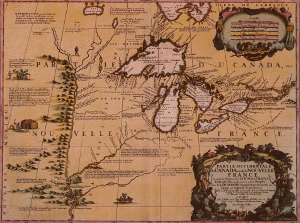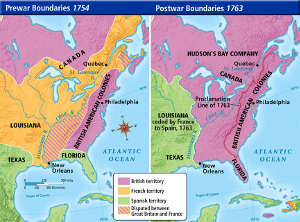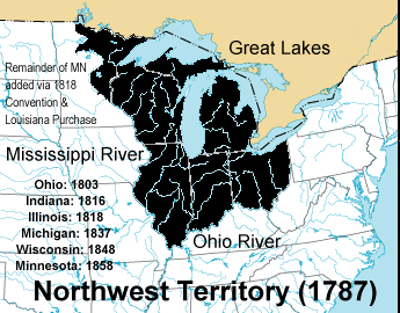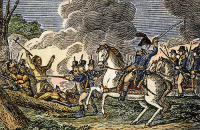The Northwest Territory
The Northwest Territory was a large amount of land created by Congress in the form of the Northwest Ordinance in 1787. The Northwest Territory included what is now Illinois, Indiana, Michigan, Ohio, and Wisconsin, as well as part of Minnesota. In earlier days, this was called the Old Northwest. The area that made up this territory was first explored and claimed by France, in the 17th Century. The French explorer Jean Nicolet is thought to have been the first, at what is now Green Bay, Wisc. He certainly wasn't the last, followed as he was by other explorers like Cadillac and La Salle and Marquette and Jolliet and by missionaries like Dablon and Marquette. The French set up trading posts, at Kaskaskia and Prairie du Chien and Vincennes, and forts, like Fort Detroit and Fort Mackinac. British settlers arrived on the scene eventually, in the form of trappers and traders and then settlers. It wasn't long until the British and French came into conflict, economically and militarily. War came in 1754, in the form of the French and Indian War, and ended in 1763, with a British victory that forced the French to vacate most of their North American lands. Great Britain then issued the Proclamation of 1763, which prohibited English settlers to advance west past the Appalachian Mountains. This angered American colonists, and such disagreements over the future of settlement were among the causes of the widespread revolt that led to the Declaration of Independence and the Revolutionary War. During that conflict, George Rogers Clark led a force that captured Kaskaskia and Vincennes, and Virginia claimed a large part of the Old Northwest, even giving it a name–Illinois County. In the newly formed United States, three other states made land claims in the Old Northwest: Connecticut, Massachusetts, and New York. An argument ensued among the other states, at one point stalling the adoption of the Articles of Confederation, and the federal government solved the problem by assuming ownership of all of the land. The ownership took the form of cessions, from the four states to the federal government, from 1780 to 1786. Congress hoped to raise money from the sale of this new western land and so passed two Land Ordinances in successive years, 1784 and 1785, dividing the Old Northwest into townships, to be further divided into lots measuring one mile square, or 640 acres. The asking price was too high, and Congress had to settle for selling to a group of investors called the Ohio Company, for a much lower price. On July 13, 1787, Congress approved the Northwest Ordinance, which created the Northwest Territory, and named Arthur St. Clair as governor. Clair had served in the British Army during the French and Indian War and then the Continental Army during the Revolutionary War. He was President of the Continental Congress when the Northwest Ordinance was passed, and he resigned that post to take the new one. He instigated the territory's first laws, known as Maxwell's Code, after the man who had printed the laws, William Maxwell. St. Clair lived in Cincinnati, which he named, and served as governor until 1802. Once the Northwest Territory reached a population of 5,000 free adult men, residents were able to form a territorial legislature and send a nonvoting member to Congress. The word "free" was key: The Northwest Ordinance prohibited territorial residents from owning slaves. (In a nod to the future Fugitive Slave Law, the Sixth Articles of the Ordinance also contained these words: "That any person escaping into the same, from whom labor or service is lawfully claimed in any one of the original States, such fugitive may be lawfully reclaimed and conveyed to the person claiming his or her labor or service as aforesaid"; in other words, people who lived in the Northwest Territory could not own slaves, but they also could not stop slaveowners from states that did allow slavery from seizing runaways who had sought freedom in the Northwest Territory.) The Ordinance also guaranteed the territories' residents the right to own property, the right to trial by jury, and the right to freedom of religion. A wave of settlement followed. The Ordinance also gave Congress the power to create three to five states, eventually; first, they would be territories. Once a territory was formed, Congress would appoint a governor, a secretary, and three judges. Once a territory had a population of 60,000 free people, it could apply for statehood. Native Americans, especially, and British as well protested this settlement, sometimes violently. A series of conflicts ensued. A Native American forced led by Miami Chief Little Turtle and Shawnee Chief Blue Jacket had spectacularly routed a group of U.S. Army troops led by St. Clair in 1791, resulting in several hundred deaths. Congress organized a Northwest Territory territorial legislature in 1799. The following year, the carving up of the territory began:
In and among those territorial establishments were more conflicts between Americans and a combination of Native Americans and British, culminating in the War of 1812. At the conclusion of that war, Great Britain renounced all claims to what had been the Old Northwest. |
|
Social Studies for Kids
copyright 2002–2025
David White






 The American retaliation was fierce, capped by the 1794
The American retaliation was fierce, capped by the 1794 
